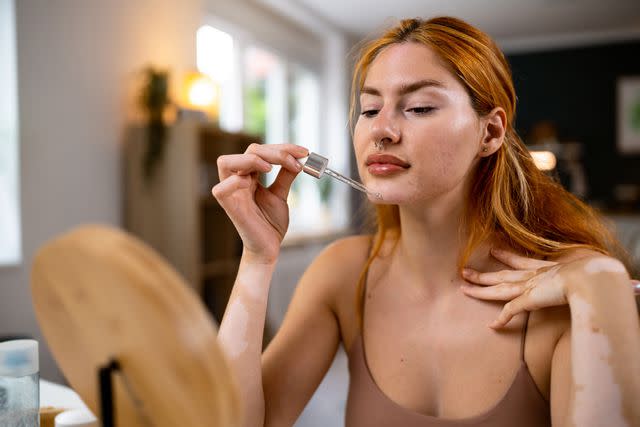8 Ways to Get Rid of Uneven Skin Texture

Getty Images: Visual Vic
If it seems like you're forever on a quest for skin as smooth as silk, join the club. While even skin that doesn't bear signs of texture isn't impossible, it's also not the easiest feat. That's because bumps, dry patches, lines and wrinkles, and rough skin are normal.
Related: How to Get Rid of Strawberry Skin, According to Dermatologists
Truth be told, there's no one cause of textured skin since it usually stems from a combination of factors, so there's no one-size-fits-all solution for treating it. It's essential to figure out the root cause of uneven texture to improve your skin since different reasons require different treatments. Then, develop a skincare plan of attack. No matter the cause of textured skin or how it looks and feels, these are the best solutions for improving it so it's smooth and soft.
Meet Our Expert
David Kim, MD, a board-certified dermatologist who studied at Stanford University
Teresa Song, MD, a board-certified dermatologist who practices in New York City
Anar Mikailov, MD, a board-certified dermatologist and founder of KP Away
What Is Skin Texture?
Simply put, skin texture is all about the smoothness and softness of the skin, but more times than not, textured skin is rough, uneven, or bumpy. According to Anar Mikailov, MD, a board-certified dermatologist, and founder of KP Away, and co-author of Fitzpatrick's Color Atlas and Synopsis of Clinical Dermatology, 9th Edition, all skin types can display symptoms of uneven skin texture, including roughness, bumps, wrinkling, flakiness, or dryness. A buildup of dead skin cells, redness, and hyperpigmentation usually accompany textured skin.
Uneven skin texture is typical in dry skin since it lacks moisture. But dry skin isn't the only skin type to feel the effects of rough skin. David Kim, MD, a board-certified dermatologist, says acne and eczema-prone skin, as well as skin that experiences keratosis pilaris (an abnormal buildup of keratin in hair follicles on the body) and sebaceous keratosis (scaly or waxy discolored spots), can feel irregular, too.
And it's not just the face where textured skin arises; the body also encounters it. "The skin on the body can be dry, bumpy, rough, or oily, just like the face," Dr. Kim says.
Causes of Uneven Skin Texture
Clogged and enlarged pores, acne and acne scarring, and even sun damage can cause the skin to feel uneven. "Irritation bumps, which can arise in sensitive skin, and the accumulation of dead skin cells from a lack of exfoliation all contribute to textured skin, too," says Teresa Song, MD, a board-certified dermatologist.
As the skin ages, the natural rate at which skin cells turnover starts to slow, which leaves behind a layer of dead skin cells, making the skin feel unsmooth. Also on the decline is the skin's ability to produce sebum, which acts as a natural moisturizer, leading to dryness. "Age-related changes like a loss of volume and moisture, accumulated sun damage, and a decrease of collagen and elastin can all contribute to wrinkles, rough, textured skin, and thinning of the skin," says Dr. Song.

Getty Images: Maksym Belchenko
"Active acne in the form of red-pink bumps or whiteheads can also cause the skin to look irregular," adds Dr. Mikailov. Acne can leave behind scars, which also contribute to bumpy skin. "Scars create a loss of skin through either atrophic change (loss of skin thickness) or hypertrophic change (excess skin thickness)," he explains.
Tips
Weather changes can influence skin texture, too. For example, dry skin can take on a mind of its own during winter since the air lacks moisture and can leave the skin feeling thirsty and rough, while the hot summer months bring more sun exposure and sun damage, resulting in skin that feels dehydrated and leathery.
Dr. Kim adds that the wrong skincare products can also instigate textural changes. "For example, people with oily skin who use products that are too heavy, creamy, or lipophilic (attracts to oil and gets trapped in it) ingredients, their pores will become clogged, causing the skin to feel bumpy," he explains. One common ingredient Dr. Kim says many people overlook is vitamin E. "Vitamin E is lipophilic, so it gets trapped in the pores and accumulates, leading to congestion and bumpy skin that could manifest as an acne flare-up or milia."
Dry and sensitive skin should be cautious of active ingredients, like retinol and exfoliating acids, ensuring they aren't too harsh or irritating. "Even though these ingredients benefit the skin, they can over-strip and irritate it and compromise the skin barrier, leading to extreme dryness that can result in painful microtears, and in extreme cases, an impetigo infection," Dr. Kim says.
How to Tell If Your Skin Texture Is Uneven
Most of the time, uneven skin texture looks rough, scaly, or bumpy, but it can also feel dry or flaky. "There can be indentations from atrophy or scarring that you can feel," adds Dr. Song. Facial skin is more sensitive than the skin on the body, so textural changes are often more evident on the face.
If you run your fingers across your skin and it feels rough, dry, bumpy, or inconsistent, your skin's texture is uneven. "There can also be a noticeable elevation in the skin or bumps versus depressions or atrophy to the touch," Dr. Mikailov says. "You can feel the unevenness in the skin simply by touching it," he adds.
How to Treat Uneven Skin Texture
Here are eight ways to treat uneven skin texture, starting with identifying the root of it.
Determine the Cause of Your Bumps
To reduce the look of bumpy skin, you'll need to hone in on what is causing it. Dr. Song says if irritation bumps are a problem, use simple moisturizing and calming ingredients such as niacinamide and hyaluronic acid. "If the bumps are from clogged pores, target them with exfoliating ingredients like AHAs and BHAs, an over-the-counter retinol, or a prescription retinoid," she adds. If bumpy skin is also itchy and red, she says the cause may be dermatitis, which is best addressed with prescription anti-inflammatory creams.
Product selection is critical since creamy, thick, or rich formulations can clog the pores and cause bumps in acneic skin. "I always recommend acne-prone skin to use anti-acne ingredients like salicylic acid, benzoyl peroxide, niacinamide, adapalene, and light, non-comedogenic moisturizers," Dr. Mikailov says.
When keratosis pilaris (KP) leads to bothersome bumpy skin on the body, specifically the arms, legs, and beyond, Dr. Mikailov suggests treating it with a lipid barrier emollient like KP Away Lipid Repair. "A mild exfoliant, like a low-dose AHA or a PHA, can also help."
Exfoliate to Minimize Roughness
If the skin feels rough due to a buildup of dead skin and clogged pores, exfoliating the skin with an exfoliating cleanser, moisturizer, or peel can make a significant difference. Dead skin cells trapped on the skin's surface make it feel rough and look dull. "An exfoliant can help loosen the "glue" between the skin cells so they slough off easier, revealing new skin underneath and promoting cell turnover," Dr. Mikailov says.
Dr. Kim recommends using an enzymatic exfoliator with lactic, glycolic, or mandelic acid weekly to make the skin feel smoother. Avoid using exfoliators with sharp pieces of nuts or shells or anything too abrasive, which can damage the skin. It's also important not to over-exfoliate the skin, which Dr. Song says can cause it to become sensitized quickly and lead to irritation bumps and uneven texture.
At the dermatologist's office, chemical peels can exfoliate even deeper to even the skin. Alpha hydroxy acids (AHAs) are a primary constituent of professional-strength peels and remove dead skin cells. Beta hydroxy acids like salicylic acid help clear clogged pores and limit breakouts.
Related: How to Exfoliate Your Face Correctly, According to Dermatologists
Incorporate Vitamin C to Stimulate New Collagen
Antioxidant-rich vitamin C does more than brighten the skin and protect it from environmental aggressors. It’s also a powerhouse for stimulating collagen and elastin production to firm and smooth out uneven skin while repairing it.

Getty Images: Nadija Pavlovic
Add in Retinol or a Retinod to Stimulate Cell Turnover
Retinol and other retinoids help stimulate collagen production and aid in proper skin cell turnover to soften the skin to improve skin wrinkling. "The only product that can meaningfully improve the appearance of acne scars is prescription tretinoin or high-dose retinol (0.5% or above)," Dr. Kim says. "These vitamin A-derivatives boost collagen production to help alleviate and improve deep scars."
Related: What Does Retinol Do? Experts Break Down the Go-To Ingredient
Find a Good Daily Moisturizer
The skin naturally loses hydration with age, but dry skin can also transpire from over-cleansing and skin-stripping products and ingredients, so a skin-appropriate moisturizer can help fight scaly skin.
Use a moisturizer that benefits your skin type. Dr. Kim says oily skin should stick with light gel moisturizers, which will hydrate the skin without making it feel greasy. Dry skin should use a thick, creamy, rich moisturizer with ceramides and fatty acids to repair the skin barrier and deliver moisture instantly. "In severe cases of dry skin, using an emollient, such as Vaseline or Aquaphor, can be effective," he shares.
Always Wear Sunscreen
UV rays deplete collagen, elastin, and hydration levels, causing the skin to look dull and bear signs of dryness, roughness, and lines and wrinkles. Wearing a minimum of SPF 30 daily prevents the skin's texture from changing from the sun. Dr. Kim calls sunscreen "the best anti-aging skincare product you can use because it helps with hyperpigmentation, age spots, and sun spots, and is an essential skin care product every day, year around."
Invest in Microneedling
Microneedling has become a skin-texture rejuvenating favorite because it improves rough skin texture. The treatment, safe for all skin tones and types, relies on tiny needles, hence its name, stamped into the skin to create micro-injuries to incite a healing response. Then, as new collagen kicks into high gear, pores begin to look smaller, scars flatten out, and the skin has a glowy, bouncy appearance. Adding radiofrequency (RF) to microneedling treatments (built into the handpiece and delivered simultaneously to the skin) goes even further in the collagen stimulation department to help firm the skin.
Consider a Laser Treatment
Laser resurfacing is the way to go for more serious skin texture issues. Baby fractional lasers, like Moxi and Clear and Brilliant, to more ablative lasers, such as CO2, can improve skin texture depending on the degree of it and its cause. "For in-office resurfacing, lasers like Clear and Brilliant or Fraxel Dual will improve skin texture, fine lines, hyperpigmentation, and acne scars and keep the skin glowing while CO2 lasers or a non-ablative laser, such as Fraxel, can help alleviate and improve deep scars," Dr. Kim says. "We can adjust the settings of Fraxel to improve the skin texture and pores without causing complications."
For more InStyle news, make sure to sign up for our newsletter!
Read the original article on InStyle.


